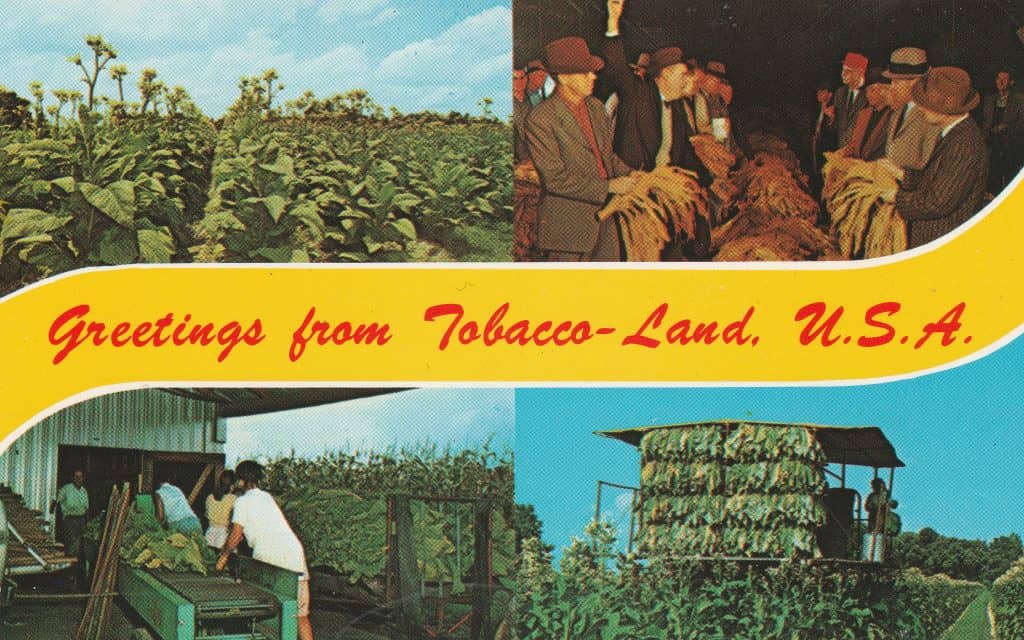
Native Americans were the first to cultivate tobacco in Mexico around 1400 to 1000 B.C. The tribes of the northeastern woodlands, which inhabited the area that would become the northeastern and midwestern United States, as well as southeastern Canada cultivated tobacco as a trade item.
Tobacco was smoked socially and ceremonially to seal trade agreements and peace treaties. It was also used medicinally. The three ships of the Jamestown-bound English settlers landed at Strawberry Banks (now Hampton, Virginia) on April 30, 1607. They found the banks abounding with wild strawberries and feasted on them after months at sea. The Kecoughtan tribe, the inhabitants of the area, greeted the settlers warily. Later the Kecoughtan smoked tobacco with the settlers.
Without tobacco, the 1607 Jamestown colony would have collapsed. Tobacco provided the Virginia colonists with a lucrative crop that could be exported. Tobacco farmers prospered as Europeans smoked, chewed, and snuffed tobacco. The crop created the thirteen colonies’ first millionaire, tobacco planter Robert Carter (1664–1732). “King Carter,” owned over 300,000 acres in Virginia and 3,000 slaves.
Cultivation of tobacco was labor intensive, and the colonists used indentured laborers from England and slaves kidnapped from Africa as their workforce. Tobacco rapidly depleted the nutrients in the soil and after three or four crops, the yield decreased. Planters led by George Washington and Thomas Jefferson experimented with crop rotation and fertilizing the fields with animal manure and marl (crushed oyster shells).
Bright Leaf tobacco, also known as flue-cured tobacco, was developed in North Carolina in the 1830’s. Heat turns the tobacco leaves yellow and improves the taste of the tobacco when smoked. It became popular with smokers in the latter half of the 19th century. Today North Carolina and Kentucky lead the United States in the cultivation of tobacco, followed by Tennessee, Virginia, Georgia, South Carolina, and Pennsylvania.
On January 11, 1964, the Surgeon General of the United States, Dr. Luther Terry issued Smoking and Health: Report of the Advisory Committee to the Surgeon General. The report linked cigarette smoking to several serious health issues including lung cancer, chronic bronchitis, emphysema, and coronary heart disease. It also noted smoking during pregnancy reduced the average weight of newborns.
The report hit Tobacco-Land like a tornado. During the 1940s, about half of Americans indicated they smoked cigarettes. After publication of the report the number of cigarette smokers began to decline. By 2023 only 11% of adults claimed to be cigarette users. The decline in the numbers caused the tobacco industry to consolidate and they closed many of their manufacturing plants, although tobacco still generates $121 billion annually in the United States.
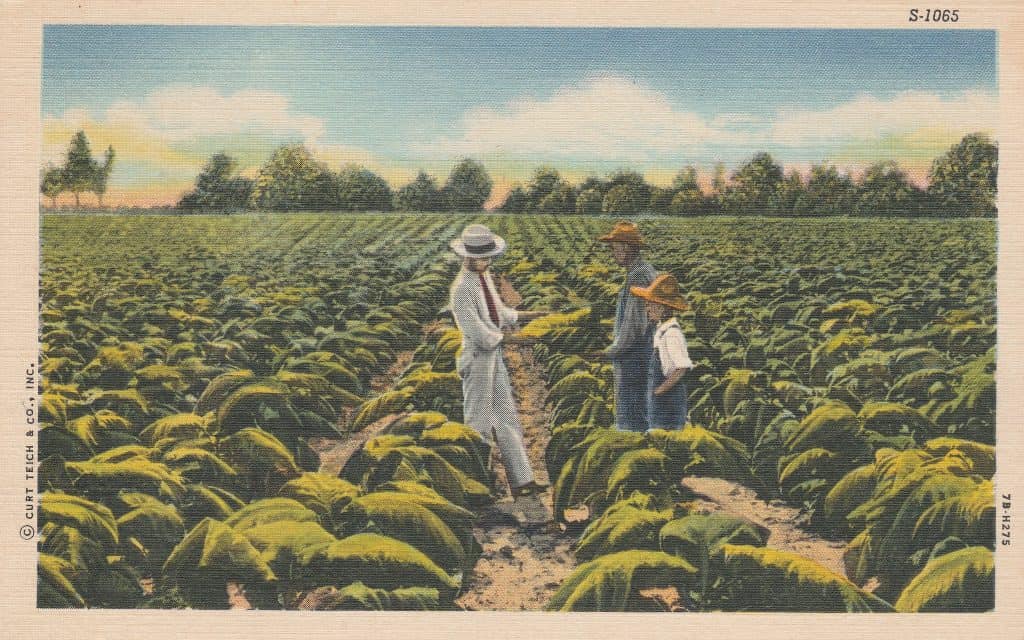
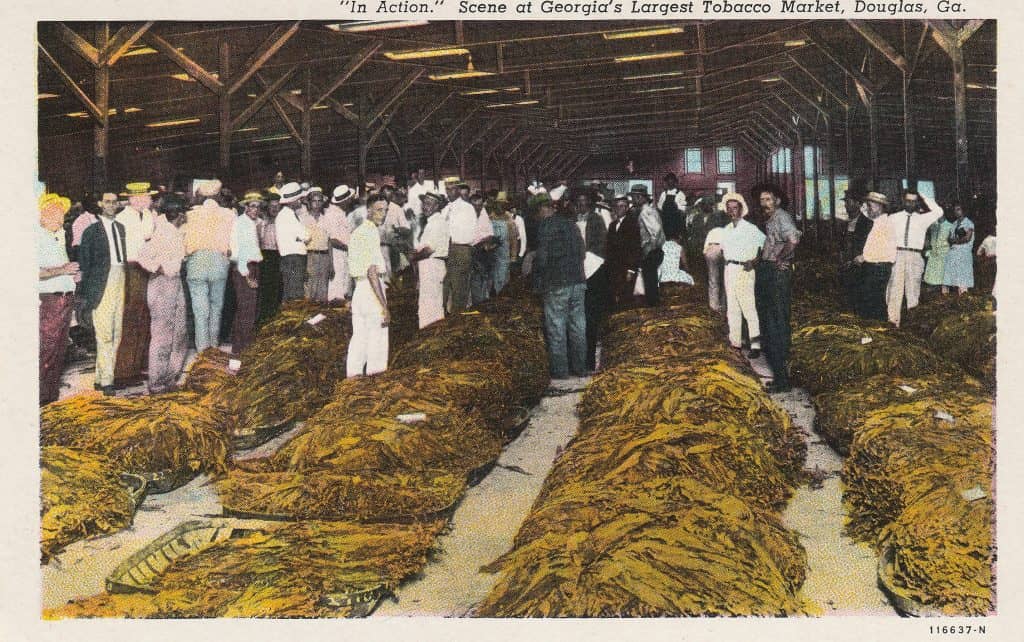
**
In 1880 when James Bonsack of Roanoke, Virginia, was 21, he invented the first cigarette rolling machine. He received a patent for his machine in 1881. Prior to his invention, a skilled cigarette roller could produce four cigarettes a minute – they were expensive and considered a luxury item.
Bonsack’s machine revolutionized cigarette production. In 1884, he entered an agreement with tobacco manufacturer James Buchanan Duke of Durham, North Carolina and by the end of the 1880s, 120,000 cigarettes were rolling out of Duke’s factory every ten hours. Due to his slashing production costs, Duke was able to cut the cost of cigarettes and create a mass market for his product.
In 1890, J. B. Duke controlled 40% of the American cigarette market. He formed the American Tobacco Company and forced his four major competitors to join the company enabling him to control 90% of the U.S. cigarette trade. He later attempted to dominate the British tobacco market leading to a dubious agreement with the British Imperial Tobacco Company to divide the world’s cigarette market.
In 1906, a case was brought against the American Tobacco Company and it was found guilty of violating the Sherman Antitrust Act. (The Sherman Act is a federal law that prohibits unfair monopolies and promotes competition among businesses.) The Supreme Court upheld the order in 1911, and Duke’s monopoly was ordered split into four separate companies, American Tobacco, Liggett & Myers, R. J. Reynolds, and P. Lorillard Company.
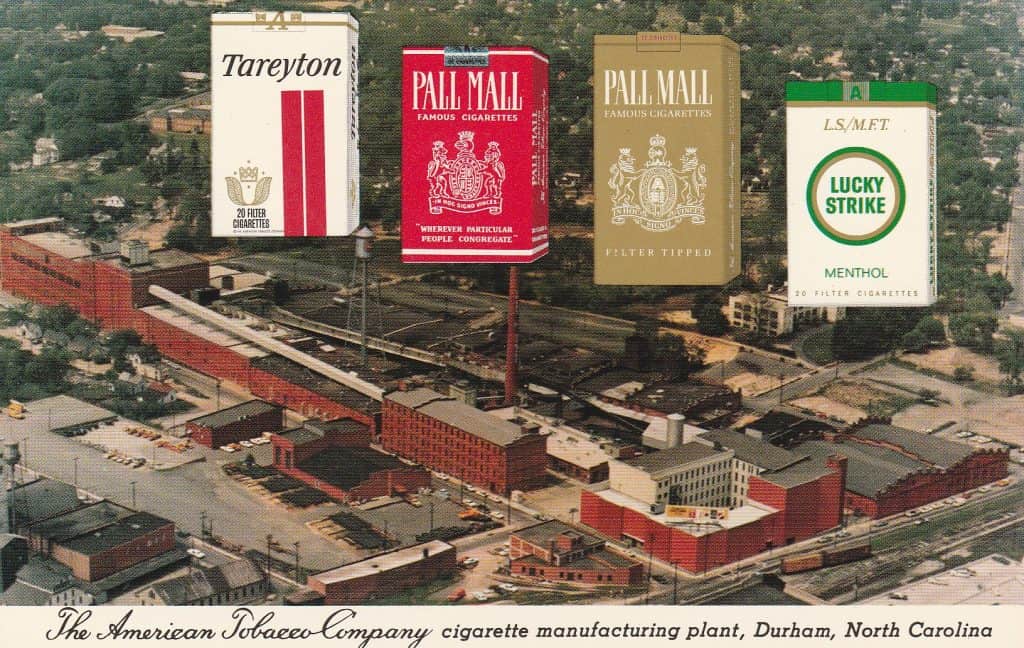
Durham, North Carolina, was a major center of cigarette manufacturing along with the nearby city of Winston–Salem (also the namesake of two cigarette brands). Richmond and Petersburg, Virginia, along with Louisville, Kentucky, were also major centers of cigarette manufacturing.
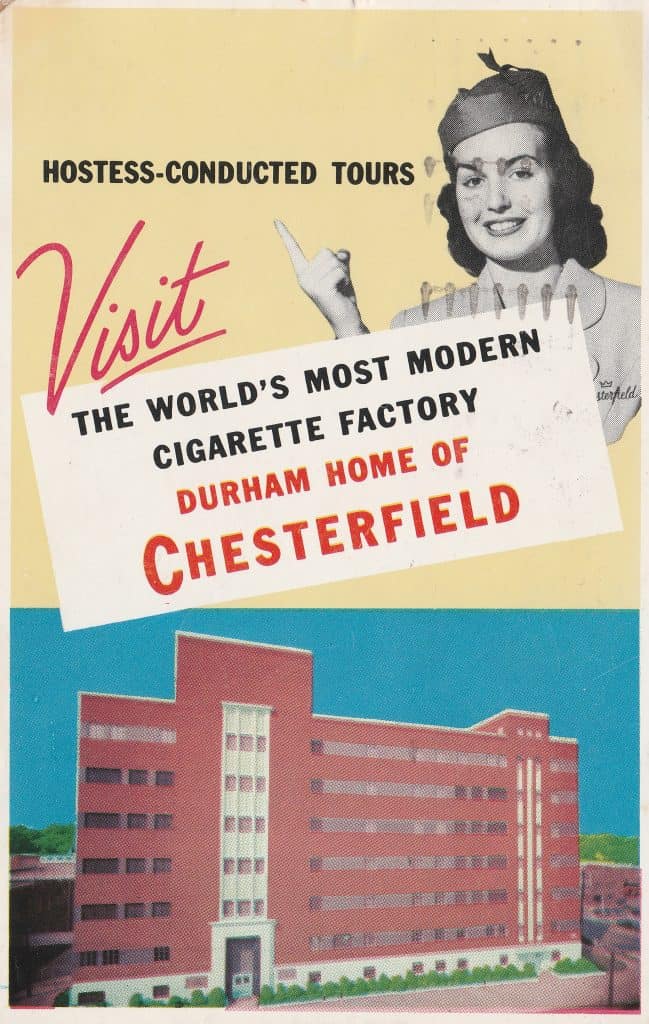
This 1950s postcard that was distributed during tours of the Liggett & Myers factory in Durham promised a fascinating tour of the world’s newest and most modern cigarette plant.
Cigarette companies encouraged smokers and non-smokers to visit their modern plants as part of their marketing efforts. Liggett & Myers began producing Chesterfield cigarettes in 1912. The brand is named for Chesterfield County, Virginia, across the James River from Richmond.
In 1926, Chesterfield became the first cigarette brand to target women in its advertising with its “Blow Some My Way” campaign.
A tour guide shows two visitors around the R. J. Reynolds Tobacco Company plant in Winston-Salem, North Carolina. Two of its cigarette brands, Winston and Salem take their names from the city. At that sprawling plant, Camel, Salem, Cavalier, and Winston cigarettes were manufactured as well as Prince Albert and Carter Hall pipe tobacco. The machine operator monitors the flow of cigarettes for packaging, removing any imperfect or damaged cigarettes. At its peak, Reynolds Tobacco employed 30,000 people (3,000 today) in Winston-Salem.
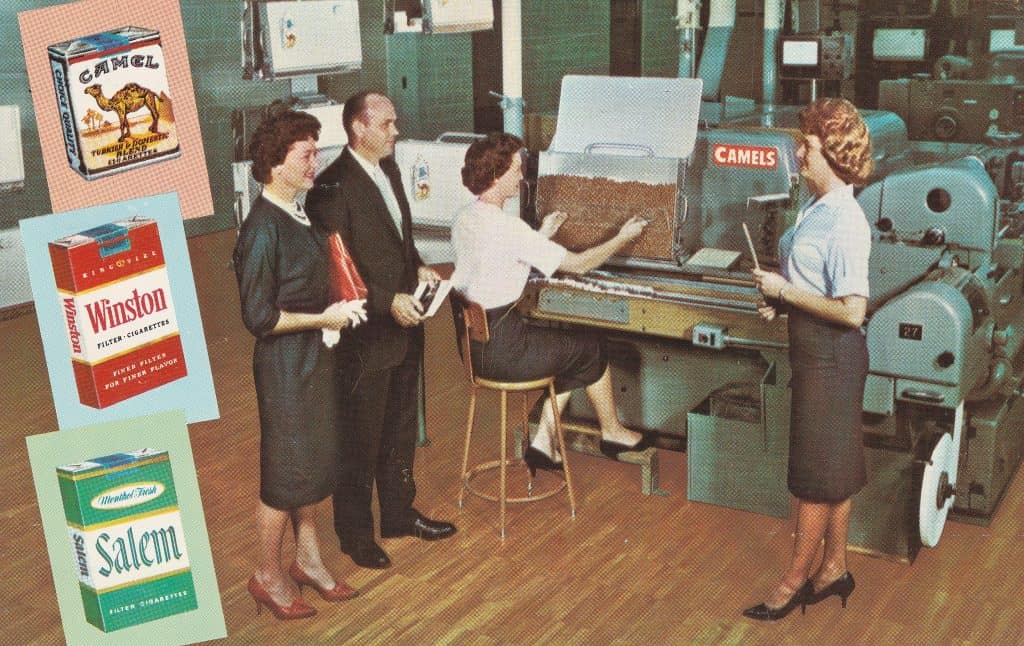
A postcard mailed in 1938 shows the Brown & Williamson Manufacturing Plant in Louisville, Kentucky. Raleigh, Wings, and Kool cigarettes were manufactured at this plant along with Sir Walter Raleigh pipe tobacco. Brown & Williamson also had plants in Petersburg, Virginia and Winston-Salem, North Carolina.
The 16-acre, South Richmond complex on Jefferson Davis Highway included four large warehouses, a processing building including a stemmery and re-drying plant, plus ancillary buildings and structures that were the company’s 1939 state-of-the-art research laboratory. At the lab, research was conducted into tobacco cultivation and processing as well as the health effects of tobacco usage. A 1955 expansion doubled the size of the 1939 building. The complex was closed in the 1980s.
The Lucky Strike manufacturing plant was located at 2600 E. Cary Street in Richmond. It closed in 1981 but has been repurposed as a loft apartment building. The Lucky Strike smokestack still stands.
In the late 1920s, advertising targeting women touted Lucky Strike cigarettes as the route to thinness. The slogan, “Reach for a Lucky instead of a sweet” increased sales 300% in the campaign’s first year. Through clever advertising that featured Hollywood celebrities Al Jolson, Clark Gable, Spencer Tracy, and Joan Crawford endorsing the Lucky brand, it became America’s leading cigarette brand in the 1930s.
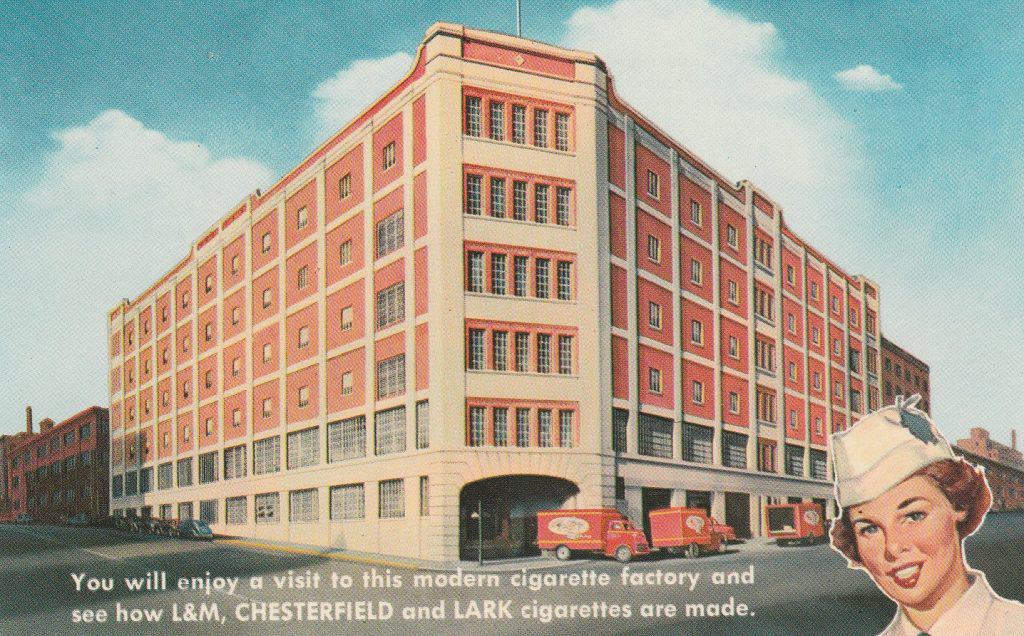
The former Liggett and Myers cigarette factory was located at Sixth and Cary Streets in downtown Richmond. My father took my brothers and me on a day trip to Richmond in the summer of 1968.
To demonstrate the plant’s machinery, our guide tore a cigarette in half. She placed the mutilated cigarette back in the line of moving cigarettes and a few minutes later, a machine spit out the cigarette before it could be packaged. At the end of the tour, in the hospitality center, adults were given a pack of cigarettes. Children settled for a Coke.
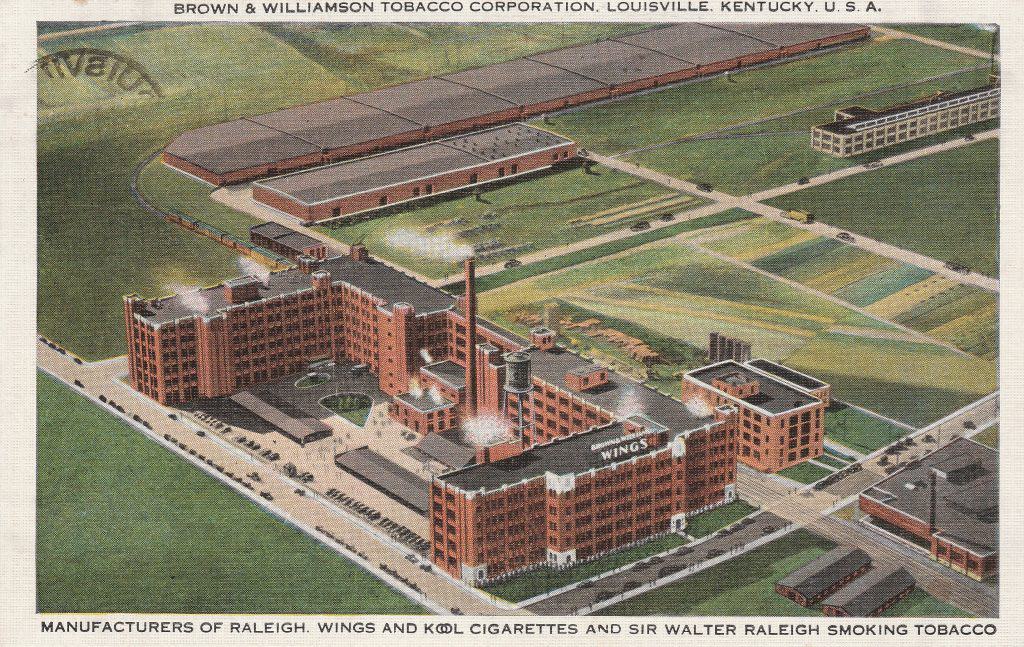
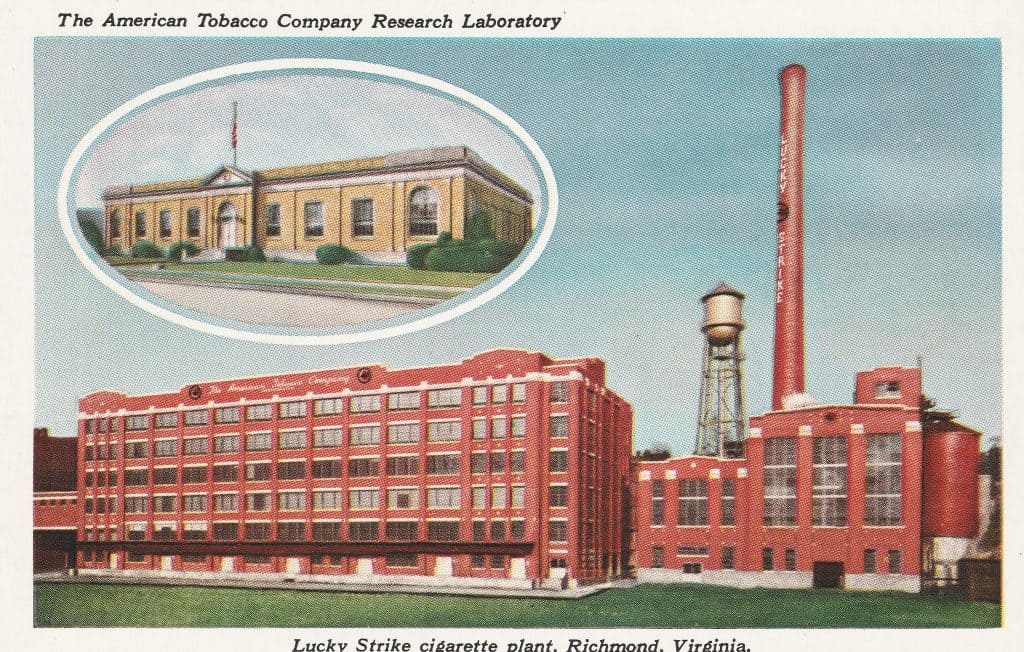
Thanks Dan, a great article. Having grown up in Richmond, I fondly remember the tobacco companies. i especially remember the tobacco warehouses on Semmes Ave with a sign that read “Quiet Please Tobacco Asleep” I’m also a tobacco postcard collector, so enjoyed seeing Dan’s cards. as well.
I’m old enough to remember cigarette commercials, and know that L.S./M.F.T. stands for “Lucky Strike Means Fine Tobacco.”
Super article Dan. So interesting to learn more about our regional tobacco industry. Those companies had some great graphics on their advertisements and crate labels too!
Great article Dan, thanks for taking us through the history of tobacco and cigarette industry. Early American machinery and number of employees is fascinating.
A well done interesting article for those of us who remember the suffocating days of massive TV cigarette advertising.
As a tobacco pc collector I really enjoyed this article. Disappearing segments of Americana like this need to be remembered and shared.